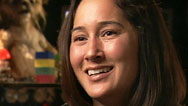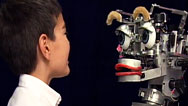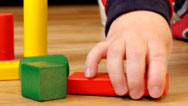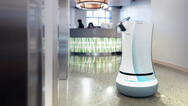Profile: Cynthia Breazeal
- Posted 11.21.06
- NOVA scienceNOW
(This video is no longer available for streaming.) "Robots have been in the deepest oceans, to Mars — but your living room is the final frontier," says MIT roboticist Cynthia Breazeal. Thinking outside the box of traditional engineering, Breazeal designs "sociable robots" with theories of child development and parent-child interactions in mind, equipping her creations with an ability to learn and giving them expressive, human-like features.
Transcript
Profile: Cynthia Breazeal
PBS Airdate: November 21, 2006
NEIL DEGRASSE TYSON: Life, today, revolves around technology, and when something goes wrong, it can be so frustrating. Sometimes, you just wish machines could be a bit more helpful—nicer.
VOICE FROM MACHINE: Neil, this one's stuck.
NEIL DEGRASSE TYSON: Thank you.
PRINTER: You're welcome.
NEIL DEGRASSE TYSON: Well, here's a scientist who wants to change things. She's working hard to design machines that are so much like us, we might even consider them our friends.
PRINTER: Friends.
NEIL DEGRASSE TYSON: This is Leonardo, and today is his annual checkup, or maybe I should say tune-up.
RICHARD LANDON (MIT): A little of both.
CYNTHIA BREAZEAL: It's both. It's a checkup and a tune up. Yeah.
NEIL DEGRASSE TYSON: You see, Leonardo is a robot, but the engineer who designed him thinks of him as much more than a machine.
CYNTHIA BREAZEAL: Do we have the tongue again? Where's Jessie? Jessie?
NEIL DEGRASSE TYSON: Cynthia Breazeal thinks of him as a "creature."
CYNTHIA BREAZEAL: And does the nose wrinkle?
It's ready to go.
Okay, cool.
NEIL DEGRASSE TYSON: That's because, when Leonardo's been put back together and has his fur coat on, he's what you call a "sociable robot,"...
MATT BERLIN: Hello, Leo. Can you hear me?
NEIL DEGRASSE TYSON: ...a new breed of robot that Cynthia and her students are designing, in the Robotic Life lab at MIT.
CYNTHIA BREAZEAL: This is the most amazing place you can imagine.
MATT BERLIN: It's like working in Santa's workshop.
Leo, this is Elmo. Can you find Elmo?
NEIL DEGRASSE TYSON: Cynthia's goal is to make robots that aren't just smart, but that can learn the way people do, communicate the way people do, even become our friends.
CYNTHIA BREAZEAL: What does it really mean to design a robot that understands and interacts and treats people as people?
NEIL DEGRASSE TYSON: If anyone can answer this question, it'll be Cynthia Breazeal.
BOBBY BLUMOFE (Cynthia Breazeal's husband): She's fearless, so she tries anything. And she just seems to have no concern, whatsoever, that it might fail. She just does it. And I can't think of any cases where it actually has failed.
CYNTHIA BREAZEAL: If you look at the field of robotics today, you can say robots have been in the deepest oceans, they've been to Mars, you know? They've been all these places, but they're just now starting to come into your living room. Your living room is the final frontier for robots.
NEIL DEGRASSE TYSON: That's because the living room is not an easy place for a robot to exist.
After all, robotic vacuums, like this one, that are supposed to clean your house by themselves, can't tell the difference between a chair leg and a human leg. They're just things to avoid, or, in this case, escape from.
But for robots to become more than just tools, for them to become our partners, as Cynthia hopes, they need the same social skills as people, including emotion.
CYNTHIA BREAZEAL: Through our evolution, we're so specialized for social interaction. So, if you can really design robots that can interact with people, in this very natural, interpersonal way, I think that would be great. You wouldn't have to have people read manuals, in order to operate them. They'd be able to just interact with a robot the way that they would want to, which we think will be as people interact with other living things.
NEIL DEGRASSE TYSON: But wait a minute.
ANTHONY DANIELS As Voice of C3PO From Star Wars: I've had just about enough of you.
NEIL DEGRASSE TYSON: Robots with emotion? Isn't that just something from the movies?
In Cynthia's case, that's exactly where it started.
CYNTHIA BREAZEAL: I was about 10 years old, and I saw the first Star Wars movie.
ANTHONY DANIELS As Voice of C3PO From Star Wars: Excuse me, sir, but that R2 unit is in prime condition, a real bargain.
CYNTHIA BREAZEAL: You saw R2D2 and C3PO, and it was, like, that is the coolest thing I've ever seen.
ANTHONY DANIELS As Voice of C3PO From Star Wars: Now, don't you forget this.
CYNTHIA BREAZEAL: R2D2 and C3PO were really kind of your, your sidekicks. They were really kind of your, your friends.
BOBBY BLUMOFE: That was really sort of the beginning of her inspiration to do what she does now.
NEIL DEGRASSE TYSON: The daughter of two scientists, Cynthia had robots on the brain, and in third grade in Livermore, California, she wrote a story that was strangely prophetic.
CYNTHIA BREAZEAL: I talked about this robot that stole huckleberry pies, that apparently was a robot that was created by the Klingon Empire. The last sentence, I think, was perhaps the most salient, which is, "And its feelings run on a computer." So, I mean, even then, it was just kind of a given for me that robots would have emotions and feelings.
NEIL DEGRASSE TYSON: Her teacher's only comment: "Proofread next time."
Cynthia's passion for robots soon switched to sports.
BOBBY BLUMOFE: She was actually a fairly accomplished tennis player...soccer and all these things, growing up. That took me by surprise. I hadn't really expected that she was such a jock. I would have expected, maybe, more of an egghead.
NEIL DEGRASSE TYSON: Well, she did wind up at MIT, where she studied electrical engineering and computer science with Rodney Brooks, who was designing robots inspired by living, breathing creatures.
RODNEY BROOKS (Massachusetts Institute of Technology): Cynthia came to my lab just a little while after we'd started building robots based on insects.
CYNTHIA BREAZEAL: And I thought, you know, if we are ever going to see those robots that we saw in Star Wars in the real world, it's going to start in a place like this.
NEIL DEGRASSE TYSON: With Brooks, she built a robotic bug named Attila, and then moved up the food chain to working on a humanoid robot called Cog, who was strangely adept at playing with Slinkys®.
RODNEY BROOKS: When we first thought about Cog, we thought about the all-intelligent robot that was going to be able to manipulate the world and do things. We weren't thinking about how it was really going to interact with people.
NEIL DEGRASSE TYSON: But Cynthia wanted to make a robot you can relate to, a robot that would learn because people would want to teach it.
MATT BERLIN: She has a vision of robots: that you build them starting with the social interaction, and you build the intelligence out from that.
RODNEY BROOKS: Cynthia came up with the phrase "appliance or friend."
NEIL DEGRASSE TYSON: But how do you make a robot that's more friend than appliance?
Long before Cynthia had her own kids, Ryan and Nathan, she hit on an idea: what if you could get people to relate to a robot in the same way a parent relates to a child?
CYNTHIA BREAZEAL: If you look at the way an adult interacts with an infant or a very young child, you, fundamentally, have this highly sophisticated being interacting with an immature version of it. But yet you could still have a very genuine interaction. So, we leverage that, in building these robots that are also very youthful in their nature.
It's a little trickier with the robots, because the robots, of course, don't have these wonderful little brains and bodies that infants have, you know? It's a sort of very low-pass, kind of crude approximation of that.
NEIL DEGRASSE TYSON: Beginning in the late 1990s, Cynthia rolled up her sleeves and got out the toolkit to build a new kind of robot, based on theories of child development.
RODNEY BROOKS: She's willing to have way out ideas and pursue them. At the same time, she will delve into any technology, to put all the pieces together to make it happen.
NEIL DEGRASSE TYSON: What she came up with was a robotic head named Kismet, with baby-like features, such as prominent eyes, to draw people into a social relationship.
WOMAN : You're such a cute little robot.
NEIL DEGRASSE TYSON: She programmed Kismet to analyze the emotional intent of the person speaking to it, based on the pitch and intensity of their voice.
WOMAN: No.
NEIL DEGRASSE TYSON: Then, all on its own, Kismet computed the right emotional response, which it expressed in its face and posture and voice.
CYNTHIA BREAZEAL: People very quickly would become enamored and attached to the robot. But you almost can't help it, because it was really adorable.
MAN: Kismet, I think we've got something going on here, you and me.
RODNEY BROOKS: Cynthia managed to get this being with a presence. Before Cynthia's work with Kismet, the question was, "How does the robot react to the world?" What Cynthia brought was, "How do people react to the robot?"
NEIL DEGRASSE TYSON: Overnight, Kismet and Cynthia were superstars.
The name Kismet means "fate" in Turkish. And, around this time, Cynthia sent a fateful email to someone she had met a few years before.
BOBBY BLUMOFE: And the email is basically, you know, "Hi, it's Cynthia. Do you remember me?" Which I thought was kind of a funny thing, because of course I remembered her.
NEIL DEGRASSE TYSON: Cynthia and Bobby were eventually married, but not before Hollywood called.
Stephen Spielberg was just finishing the movie A.I., a futuristic tale about the day scientists would program robots with the ultimate human emotion.
WILLIAM HURT (As Professor Hobby, from A.I./Film Clip): Tell me, what is love?
CYNTHIA BREAZEAL: I met with Steven Spielberg and gave him a little primer on A.I. and met Stan.
NEIL DEGRASSE TYSON: Stan was Stan Winston, legendary creator of movie creatures like the robots in Terminator.
He had made all the robots for A.I., including a bear that befriends humans and has emotions.
WOMAN from AI/Film clip: His name is Teddy.
CYNTHIA BREAZEAL: I told Stan that we should build Teddy, but we should really build Teddy.
JACK ANGEL (As Voice of Teddy from A.I./Film Clip): I am not a toy.
NEIL DEGRASSE TYSON: The result of their collaboration was the robot called Leonardo.
CYNTHIA BREAZEAL: Of course, it's after Leonardo da Vinci, not Leonardo diCaprio, which some people ask me.
NEIL DEGRASSE TYSON: It's a million dollar creature with a body by Stan and brains by Cynthia.
Cynthia and her students are using Leonardo to explore how robots can learn and communicate with people in everyday situations.
MATT BERLIN: Leo, this is Cookie Monster. Leo, can you find Cookie Monster?
NEIL DEGRASSE TYSON: To create a life-like, face-to-face interaction with people, software allows Leo to track the head of the person speaking to him. Then he stores the name and color and shape of the object in his memory.
MATT BERLIN: Very good, Leo. Leo, this is Elmo. Can you find Elmo?
NEIL DEGRASSE TYSON: Leo can also use what he learns to think for himself. When Matt tries to trick him...
MATT BERLIN: Can you find Elmo?
NEIL DEGRASSE TYSON: ...Leo catches on quickly, responding with a shrug and even a puzzled look.
Cynthia believes this kind of natural communication between people and machines is essential for robots to become part our daily lives.
DAN STIEHL (Massachusetts Institute of Technology): Cynthia's one of the best people in the world, in terms of human-robot interaction, and really understanding that it's much more than a person just pressing buttons on a machine, but really having the machine be engaging and improving that overall interaction.
NEIL DEGRASSE TYSON: The team's latest robot is a teddy bear called "the Huggable." Inspired by pet therapy, it may one day act as a companion for kids in the hospital, as well as assist their caregivers. With skin that's sensitive to touch and temperature, it's designed for physical, full-body interaction with humans.
JUSTIN KOSSLYN (Yale University): This guy has a motion classifier in him, which means he knows how he's being moved. So I can do some stuff, like bouncing him, and you can see on the screen how he's responding: pretty psyched about that. He can also respond to...if I want to be kind of evil, maybe some shaking. Grrr. And it made him sad; that was mean.
When he's used in hospitals, if a kid were to shake him, like I just did, the nurse's station could get a little message saying, "You may want to check in on Room 44."
And the last thing this guy will do is, if I put him down, he knows he's not moving anymore, and so he's going to respond by saying goodbye. Yep. Bye bye.
CYNTHIA BREAZEAL: Ooh, you got some fancy moves there.
NEIL DEGRASSE TYSON: But will we ever have an interaction with a robot that's as genuine as this? And if so, would that be a good thing?
CYNTHIA BREAZEAL: If I really didn't believe that we would have better living with robots, that robots could really be a technology that enhanced and complemented our lives, like, I mean, the way that...same reason we create any other technology, I certainly wouldn't be doing it.
BOBBY BLUMOFE: Maybe Nathan and Ryan could be among the first kids to grow up with robots that go beyond just the notion of a vacuum cleaner, but actually socially and emotionally engaging and interactive robots... that would be pretty cool!
CYNTHIA BREAZEAL: I do think, in time, people will have, sort of, relationships with certain kinds of robots—not every robot, but certain kinds of robots—where they might feel that it is a sort of friendship, but it's going to be of a robot-human kind.
Credits
Profile: Cynthia Breazeal
PBS Airdate: November 21, 2006
- Edited by
- Nathan Hendrie
- Written, Produced and Directed by
- Joseph McMaster
NOVA scienceNOW Credits
- Executive Producer
- Samuel Fine
- Executive Editor
- Neil deGrasse Tyson
- Senior Series Producer
- Vincent Liota
- Supervising Producer
- Stephen Sweigart
- Development Producer
- Vinita Mehta
- Program Editor
- David Chmura
- Post Production Supervisor
- Win Rosenfeld
- Associate Producers
- Anthony Manupelli
- Mica McCarthy
- John Pavlus
Mary Robertson
Shimona Shahi
Anna Lee Strachan - Unit Manager
- Candace White
- Production Secretary
- Fran Laks
- Animator
- Brian Edgerton
- Compositor
- Yunsik Noh
- Interns
- Karen Schrock
Alison Snyder
Brian Stillman - Music
- Rob Morsberger
- NOVA scienceNOW Series Animation
- Edgeworx
- Camera
- Sam Ameen
James Ball
Peter Bonilla - Boyd Estus Mark Knobil
- Al Lopez
Sam Painter - Sound Recordists
- Frank Coakley
Dino Distefano
Mike Filosa - Doc Jones
- Darrell Mitchell
Hing Ng
Charles Tomaras - Audio Mix
- John Jenkins
- Colorist
- Jim Ferguson
- Animation
- Vincent Liota
Sputnik - Special Thanks
- ANG Newspapers
Jim Crowley
MIT Robotic Life Group
National Museum, Bloemfontein, South Africa
Natural Resources Canada
Eric Sperling
Jude Swales
Stan Winston Studios - Archival Material
- ABC News Videosource
American Red Cross
BBC Motion Gallery
Corbis
The Egypt Exploration Society
Getty Images
Cynthia Goldsmith
Greg Hensley Productions
Indiana State Museum and Historic Sites
Iowa State University Library/Special Collections Department
Keystone-Mast Collection, UCR/California Museum of Photography,
University of California at Riverside
National Archives
The National Museum of Health and Medicine, Armed Forces Institute of Pathology, Washington, D.C.
Sam Ogden/Photo Researchers
Louie Psihoyos/Science Faction
Quill Graphics
San Francisco Chronicle
timelapse.com
US Naval Historical Center
University of Michigan Papyrus Collection
Neil deGrasse Tyson is director of the Hayden Planetarium in the Rose Center for Earth and Space at the American Museum of Natural History.
- NOVA Series Graphics
- yU + co.
- NOVA Theme Music
- Walter Werzowa John Luker Musikvergnuegen, Inc.
- Additional NOVA Theme Music
- Ray Loring
- Post Production Online Editor
- Spencer Gentry
- Closed Captioning
- The Caption Center
- NOVA Administrator
- Ashley King
- Publicity
- Eileen Campion Anna Lowi
- Researcher
- Gaia Remerowski
- Production Coordinator
- Linda Callahan
- Unit Manager
- Carla Raimer
- Paralegal
- Raphael Nemes
- Legal Counsel
- Susan Rosen Shishko
- Assistant Editor
- Alex Kreuter
- Associate Producer, Post Production
- Patrick Carey
- Post Production Supervisor
- Regina O'Toole
- Post Production Editor
- Rebecca Nieto
- Post Production Manager
- Nathan Gunner
- Producer, Special Projects
- Susanne Simpson
- Coordinating Producer
- Laurie Cahalane
- Senior Science Editor
- Evan Hadingham
- Senior Series Producer
- Melanie Wallace
- Managing Director
- Alan Ritsko
- Senior Executive Producer
- Paula S. Apsell
NOVA scienceNOW is a trademark of the WGBH Educational Foundation
This material is based upon work supported by the National Science Foundation under Grant No. 0229297. Any opinions, findings, and conclusions or recommendations expressed in this material are those of the author(s) and do not necessarily reflect the views of the National Science Foundation.
NOVA scienceNOW is produced for WGBH/Boston by NOVA.
© 2006 WGBH Educational Foundation
All rights reserved
Participants
- Matt Berlin
- MIT web.media.mit.edu/~mattb/
- Bobby Blumofe
- Cynthia's Husband
- Cynthia Breazeal
- MIT www.media.mit.edu/people/bio_cynthiab.html
- Rodney Brooks
- Massachusetts Institute of Technology people.csail.mit.edu/brooks/
- Justin Kosslyn
- Yale University
- Dan Stiehl
- MIT web.media.mit.edu/~wdstiehl/
Related Links
-

Cynthia Breazeal: Expert Q&A
Cynthia Breazeal answers questions about her life, her sociable robots, and the future of robotics in society.
-

Friendly Robots
Engineer Cynthia Breazeal talks about some of her favorite non-human companions in this audio slide show.
-

The Ape That Teaches
Why is our ability to teach so critical and so complicated? MIT's Rebecca Saxe explains.
-

Navigating the Robot Economy
With robots poised to enter the workforce en masse, is our society prepared for the transition?



